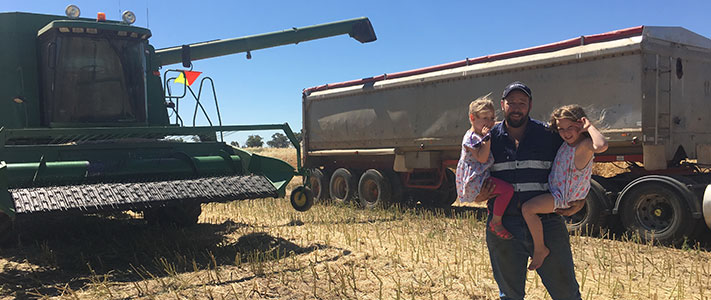The future of precision agriculture lies in data.
About
-
Category
- Product News
-
Date
14 February, 2017
-
Location
Young, NSW
About
Category
- Product News
Date
14 February, 2017
Location
Young, NSW

Above: Mingenew Irwin Group (MIG) Trials Coordinator Carlie Rowe and Bayer Customer Advisory Representative for Northern WA, Matt Willis, pictured inspecting a herbicide trial last season
Collaborative industry partners conducted trials in wheat for the Liebe Group on the Dodd family’s property near Buntine and the Mingenew Irwin Group (MIG) on the Dempster family’s farm near Arrino. The sites experienced variable seasonal conditions, with significant rainfall and crop germination not occurring until July after sowing in May at Buntine, while the Arrino site recorded a more normal season.
The trials, which received an upfront knockdown herbicide, investigated annual ryegrass control during the season, with final panicle counts conducted in October, as well as yields and return on investment (ROI) from the different pre-emergent applications.
The ROI calculations also took into account reduced pricing for some of the products used in the trial, including Boxer Gold® and Arcade®, leading into the 2018 season, however Sakura, in addition to improving weed control and yield, still showed better results.
At Buntine, Sakura reduced annual ryegrass panicle numbers from 765 per square metre in untreated plots to 176/m2, providing 77% control and an ROI of $48/ha. Application of Arcade at 2.5 L/ha with trifluralin at 2 L/ha achieved only about 57% control for an ROI of $19/ha. Sakura, together with trifluralin at 1.5 L/ha, achieved up to 81% control of annual ryegrass and recorded the highest level of brome grass suppression in the trial, resulting in an ROI of $30/ha.
In the tough conditions at Buntine, just 100 kg/ha extra yield amounted to about an extra $25/ha return.
Sakura, incorporated by sowing, even achieved similar weed control, yield and ROI to IBS application of trifluralin at 2 L/ha followed by post-emergent application of Boxer Gold at 2.5 L/ha in August. Small weeds, no stubble to intercept application, moist soil and follow-up rainfall provided ideal conditions for the post-emergent treatment at Buntine. However, the same treatment (trifluralin followed by Boxer Gold) in drier conditions at Arrino was not so successful, with control of only 55%, similar to IBS application of trifluralin at 2 L/ha plus Avadex® Xtra at 2 L/ha, and an ROI of only $21/ha. 2 L/ha plus Avadex Xtra at 2 L/ha, and an ROI of only $21/ha.
At Arrino, treatments that included Sakura achieved 71-78% control of annual ryegrass, while all other treatments provided only 40-55% control.
Trifluralin (IBS) at 2 L/ha produced a yield of 1.7 t/ha for an ROI of $24/ ha, whereas Sakura achieved a yield of 2 t/ha for an ROI of $62/ha, which increased to $74/ha when applied with 1.5 L/ha of trifluralin. All other treatments resulted in no more than $33/ha ROI.
“Bayer Customer Advisory Representative Matt Willis said although the season was difficult, it did show the consistently strong performance of Sakura across all trials and conditions.”
“When growers viewed the sites at field days, they could see the results with Sakura. It was visually quite strong,’’ Matt said.
“In a challenging season like we had, with limited rainfall, it really tested the residual control of products and showed that while control from trifluralin can be variable, Sakura is relatively stable and will activate with rainfall and provide good control.
“The Arrino trials showed that despite the extra cost with Sakura compared with trifluralin, it still returned an extra $38/ha benefit."
He said importantly, the trials showed the reliability of Sakura for minimising the amount of weed seed entering the weed seed bank, which was critical.
“Sakura could be reducing the amount of weed seed going into weed seed banks by 20-30%, compared to other pre-emergent herbicide treatments, which is an enormous reduction in seeds.’’
The Group K pre-emergent herbicide, which contains the active ingredient pyroxasulfone, controls annual ryegrass, barley grass, silver grass, annual phalaris and toad rush and also suppresses wild oats and great brome in wheat (not durum wheat), triticale, chickpeas, field peas, lentils and lupins.
Matt said he understood the trials were conducted in “dirtier’’ grass paddocks, but he said most growers also earmarked Sakura for use in paddocks with higher grass populations and were applying it about every fourth year in crop rotations.
He said the trials also continued to highlight the need for integrated weed management (IWM) strategies including harvest weed seed control, as even the best treatment was still allowing
126 annual ryegrass panicles per square meter to survive.
In the pre-emergent grass control trials conducted in 2016 in wheat at Coorow, Pithara, Nugadong and Cunderdin, Sakura treatments yielded an average 2.14 tonnes per hectare and achieved an average $73/ha ROI.
Applications of Boxer Gold applied at 2.5 L/ha achieved an average yield just under 2 t/ha for an $18/ha ROI. In addition, with 18% lower average weed control, Boxer Gold also allowed more ryegrass seed to enter the seed bank.
The addition of 1.5 L/ha of trifluralin to Sakura only added a small increase in weed control, but still returned the highest yield and ROI across the trials at 2.23 t/ha and $78/ha respectively.
The pre-eminent pre-emergent
The long residual control of Sakura makes it a standout
Control of annual ryegrass in 9 trials* across 2016 & 2017. WA (Coorow, Pithara, Cunderdin, Nugadong, Arrino, Buntine), Vic (Pyramid Hill, Wedderburn), NSW (The Rock).

Trial IDs: 16WE05, 16WE06, 16WE07, 16VD12, 16VD13, 16NA11, 17WE32, 17WE07, 17WF07.
* Some trials assessed using weed counts, other control ratings.
^ Trifluralin (480 g/L) applied at 2 L/ha in trials 16VD12, 16VD13, & 16NA11.
^^ Trifluralin 2 L/ha + prosulfocarb 2.5 L/ha only in trials 17WE07 & 17WF07.
# Two assessment timings only for 16VD12, 16VD13, 16NA11, 17WE07 & 17WF07.

.Read more articles like this by subscribing to Cultivate



